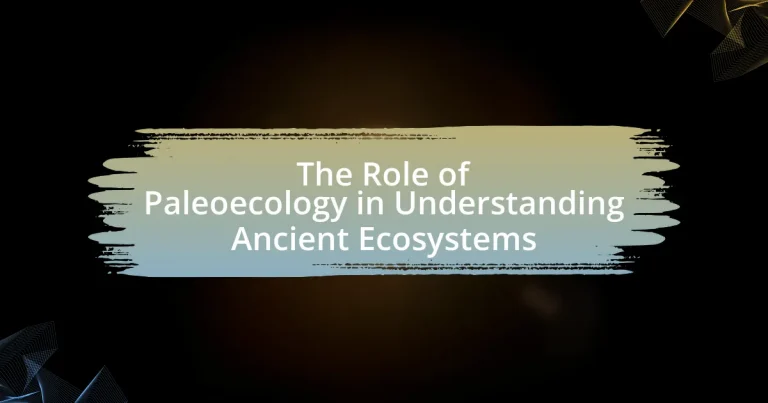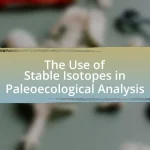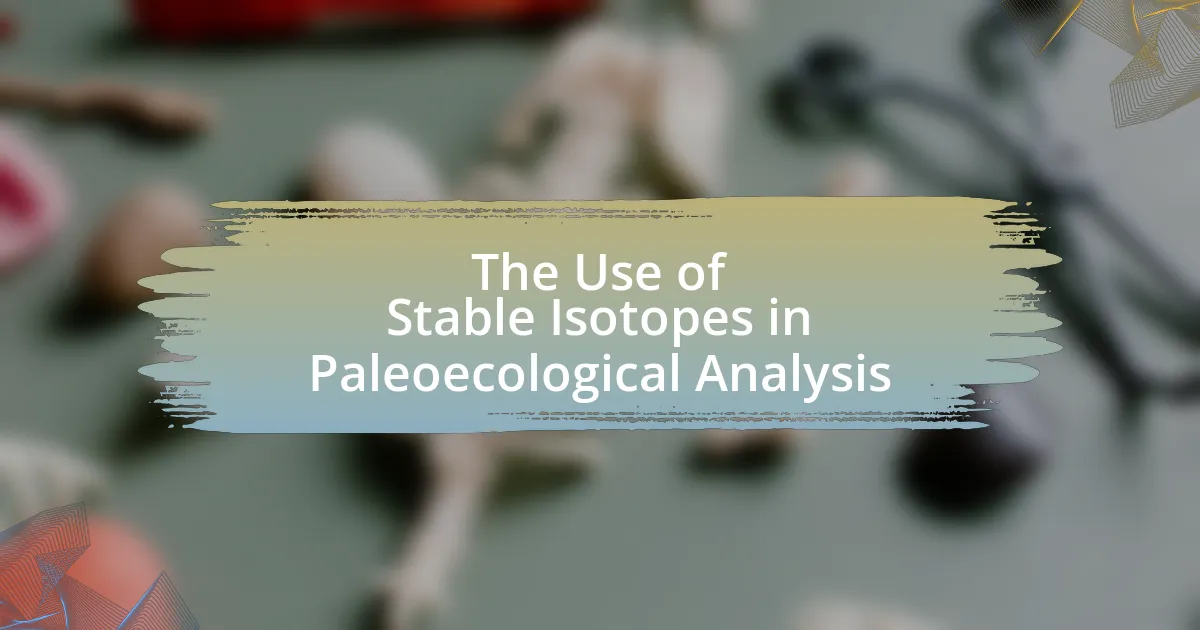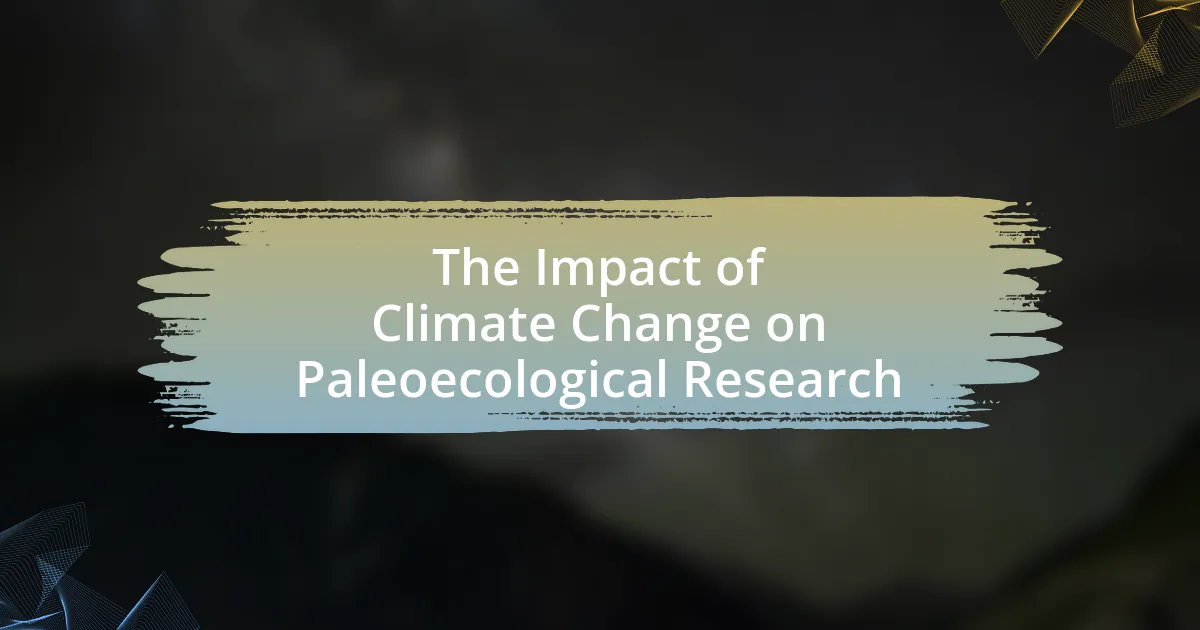Paleoecology is the scientific discipline focused on understanding ancient ecosystems through the analysis of fossil records, sediment samples, and isotopic data. This article explores the methods used by paleoecologists to reconstruct past environments, including the examination of plant and animal remains, sediment cores, and isotopic analysis. It highlights the significance of paleoecology in informing modern ecological studies, conservation efforts, and climate change predictions by providing insights into historical biodiversity patterns and ecosystem dynamics. Additionally, the article addresses the challenges faced in paleoecological research, such as gaps in the fossil record and difficulties in dating sediments, while emphasizing the practical applications of this field in habitat restoration and natural resource management.
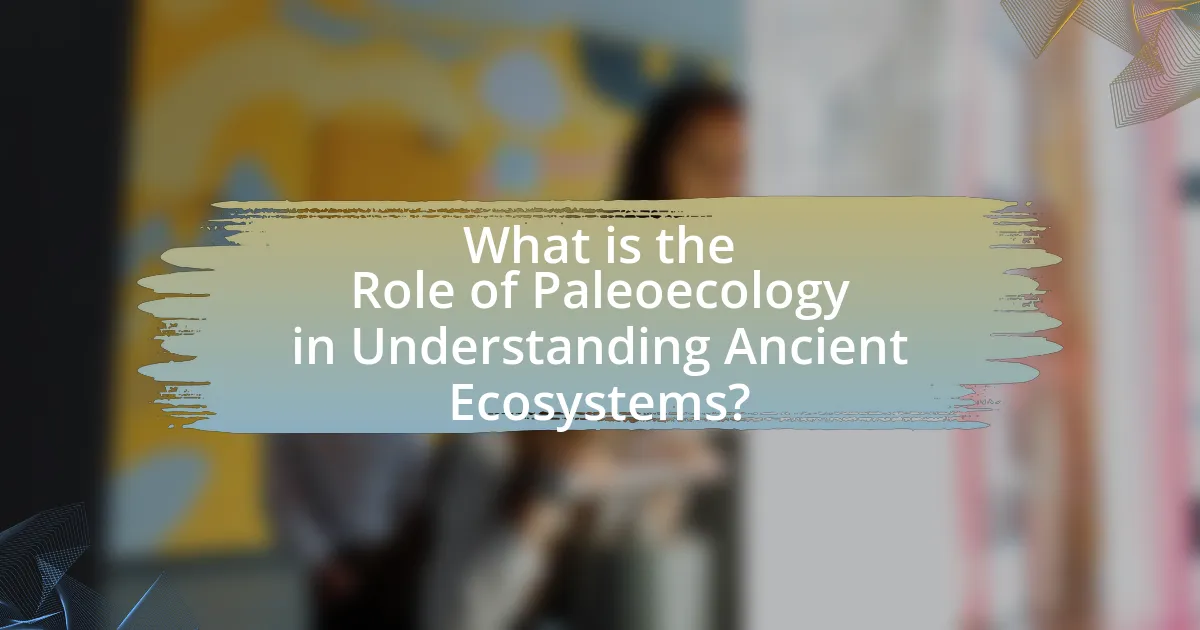
What is the Role of Paleoecology in Understanding Ancient Ecosystems?
Paleoecology plays a crucial role in understanding ancient ecosystems by reconstructing past environments and the interactions between organisms and their habitats. This field utilizes fossil records, sediment analysis, and isotopic studies to infer the climate, vegetation, and animal life of previous geological periods. For instance, studies of pollen grains in sediment cores can reveal shifts in plant communities over time, indicating changes in climate and ecosystem dynamics. By analyzing these data, paleoecologists can provide insights into how ecosystems responded to past climate changes, which is essential for predicting future ecological responses to ongoing environmental shifts.
How does paleoecology contribute to our knowledge of past environments?
Paleoecology contributes to our knowledge of past environments by analyzing fossilized remains and sedimentary records to reconstruct ancient ecosystems. This scientific discipline utilizes data from various sources, such as pollen, plant macrofossils, and animal remains, to infer climate conditions, vegetation types, and species interactions over geological time scales. For instance, studies of sediment cores from lakes have revealed shifts in plant communities corresponding to past climate changes, demonstrating how ecosystems responded to environmental fluctuations. Such insights are crucial for understanding biodiversity patterns and the resilience of ecosystems in the face of climate change.
What methods do paleoecologists use to study ancient ecosystems?
Paleoecologists use various methods to study ancient ecosystems, including sediment analysis, fossil examination, and isotopic analysis. Sediment analysis involves examining layers of soil and rock to understand past environmental conditions, while fossil examination focuses on identifying and interpreting the remains of ancient organisms to reconstruct ecological relationships. Isotopic analysis provides insights into past climate conditions and food webs by studying the ratios of stable isotopes in biological materials. These methods collectively enable paleoecologists to reconstruct ancient ecosystems and understand their dynamics over time.
How do fossil records inform our understanding of ancient climates?
Fossil records inform our understanding of ancient climates by providing direct evidence of past environmental conditions through the preserved remains of organisms. These records reveal information about temperature, precipitation, and atmospheric composition by analyzing the types of species present, their distribution, and isotopic compositions. For instance, the presence of certain plant fossils, such as ferns, indicates a warm and humid climate, while the discovery of polar ice core samples containing trapped gas bubbles shows historical atmospheric conditions. Additionally, the study of sediment layers associated with fossils can indicate changes in climate over geological time scales, allowing scientists to reconstruct ancient ecosystems and their climatic contexts accurately.
Why is paleoecology important for modern ecological studies?
Paleoecology is important for modern ecological studies because it provides insights into past ecosystems, allowing scientists to understand how ecological processes and species interactions have evolved over time. By examining fossil records and sediment samples, paleoecologists can reconstruct ancient environments and climate conditions, which helps in predicting how current ecosystems might respond to ongoing climate change. For instance, studies have shown that shifts in vegetation patterns during past climate events, such as the last glacial maximum, inform current models of biodiversity and ecosystem resilience. This historical perspective is crucial for developing effective conservation strategies and managing ecosystems in the face of rapid environmental changes.
How can insights from ancient ecosystems influence current conservation efforts?
Insights from ancient ecosystems can significantly influence current conservation efforts by providing a historical baseline for biodiversity and ecosystem function. Paleoecological studies reveal how ecosystems responded to past climate changes, species extinctions, and habitat alterations, which can inform modern strategies for resilience and adaptation. For instance, research on ancient forest ecosystems indicates that diverse species compositions enhance ecosystem stability, suggesting that current conservation practices should prioritize biodiversity to mitigate the impacts of climate change. Additionally, understanding the ecological roles of extinct species can guide the reintroduction of similar species to restore ecological balance. These insights are supported by studies such as those published in “Paleoecology and Conservation” by authors like Jackson and Williams, which demonstrate the relevance of historical data in shaping effective conservation policies.
What lessons can we learn from past biodiversity patterns?
Past biodiversity patterns reveal that ecosystems are highly dynamic and sensitive to environmental changes. For instance, the fossil record shows that mass extinction events, such as the Permian-Triassic extinction approximately 252 million years ago, led to significant shifts in species composition and ecosystem structure. These historical patterns indicate that biodiversity loss can result in long-term ecological consequences, including reduced resilience to future environmental changes. Additionally, studies of ancient ecosystems demonstrate that diverse communities are more stable and better able to recover from disturbances, as seen in the recovery of marine life after the Cretaceous-Paleogene extinction event. Thus, understanding these patterns emphasizes the importance of maintaining biodiversity to enhance ecosystem stability and resilience in the face of ongoing climate change.
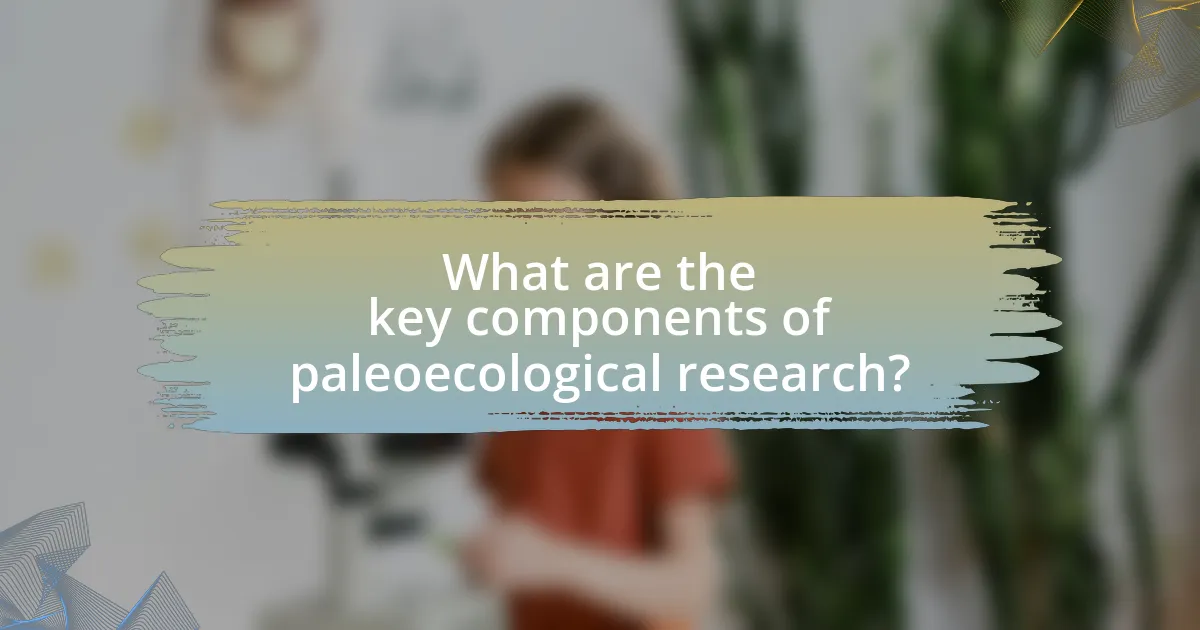
What are the key components of paleoecological research?
The key components of paleoecological research include the analysis of fossil records, the study of sedimentary deposits, and the examination of ancient climate data. Fossil records provide insights into past biodiversity and species interactions, while sedimentary deposits reveal information about historical environmental conditions and changes. Additionally, ancient climate data, often derived from ice cores and tree rings, helps reconstruct past climate scenarios, allowing researchers to understand how ecosystems responded to climatic shifts over time. These components collectively enable scientists to piece together the dynamics of ancient ecosystems and their evolution.
What types of data do paleoecologists analyze?
Paleoecologists analyze various types of data, including fossil records, sediment samples, and isotopic analyses. Fossil records provide insights into past organisms and their environments, while sediment samples reveal information about historical climate conditions and ecological changes. Isotopic analyses, such as carbon and oxygen isotopes, help reconstruct past temperatures and vegetation types. These data types collectively enable paleoecologists to understand ancient ecosystems and their dynamics over time.
How do sediment cores provide information about historical ecosystems?
Sediment cores provide information about historical ecosystems by capturing layers of sediment that accumulate over time, which contain preserved biological, chemical, and physical evidence of past environments. These cores allow scientists to analyze fossilized remains of plants and animals, pollen grains, and isotopic compositions, revealing changes in biodiversity, climate conditions, and ecological dynamics over millennia. For instance, studies of sediment cores from lakes and ocean floors have documented shifts in species composition and habitat conditions, correlating with known climatic events such as glacial and interglacial periods. This data is crucial for reconstructing past ecosystems and understanding how they responded to environmental changes.
What role do isotopes play in understanding ancient climates?
Isotopes play a crucial role in understanding ancient climates by providing insights into past temperatures, precipitation patterns, and atmospheric conditions. Specifically, stable isotopes of oxygen and carbon found in ice cores, sediment layers, and fossilized remains allow scientists to reconstruct historical climate data. For example, the ratio of oxygen-18 to oxygen-16 in ice cores indicates temperature variations over time, revealing periods of warming and cooling. Additionally, carbon isotopes in marine sediments can reflect changes in vegetation and ocean circulation, further elucidating climate dynamics. These isotopic analyses have been instrumental in identifying significant climate events, such as glacial and interglacial periods, thereby enhancing our understanding of Earth’s climatic history.
How do paleoecologists reconstruct ancient food webs?
Paleoecologists reconstruct ancient food webs by analyzing fossil evidence, isotopic data, and sedimentary records. They examine the remains of organisms, such as bones, teeth, and shells, to identify species and their ecological roles. Isotopic analysis of carbon and nitrogen in these remains provides insights into dietary habits and trophic levels. Additionally, sediment cores reveal changes in environmental conditions and biological communities over time, allowing paleoecologists to infer interactions among species. This multi-faceted approach enables a comprehensive understanding of ancient ecosystems and their dynamics.
What evidence is used to determine predator-prey relationships in the past?
Fossil evidence, including teeth marks, gut contents, and coprolites, is used to determine predator-prey relationships in the past. These fossils provide direct insights into dietary habits and interactions between species. For example, the presence of bite marks on bones can indicate predation, while coprolites, which are fossilized feces, can reveal the remains of prey species consumed by predators. Additionally, isotopic analysis of fossilized remains can help reconstruct food webs and trophic levels, further clarifying these ancient relationships.
How does plant fossil analysis contribute to understanding ancient diets?
Plant fossil analysis significantly contributes to understanding ancient diets by revealing the types of vegetation that existed in specific regions during particular time periods. This analysis allows researchers to reconstruct past environments and infer the dietary habits of ancient organisms, including humans, based on the plant species present. For instance, studies of fossilized pollen and seeds can indicate the prevalence of certain crops or wild plants, which in turn informs scientists about the nutritional resources available to ancient populations. Evidence from sites like Çatalhöyük in Turkey shows that the presence of domesticated grains correlates with shifts in human diet and settlement patterns, highlighting the role of agriculture in shaping ancient diets.

What challenges do paleoecologists face in their research?
Paleoecologists face significant challenges in their research, primarily due to the incomplete and often fragmented nature of the fossil record. This limitation makes it difficult to reconstruct past ecosystems accurately, as many species and interactions may be missing. Additionally, paleoecologists must contend with the complexities of dating fossils and sediments, which can introduce uncertainties in the timeline of ecological changes. Environmental changes over geological time scales further complicate interpretations, as modern analogs may not always apply. Furthermore, the integration of data from various disciplines, such as geology and biology, requires interdisciplinary collaboration, which can be logistically challenging. These factors collectively hinder the ability to draw definitive conclusions about ancient ecosystems.
What limitations exist in the fossil record?
The fossil record has several limitations, primarily including incompleteness, bias in preservation, and difficulty in interpreting ecological contexts. Incompleteness arises because not all organisms fossilize, leading to gaps in the record; for instance, soft-bodied organisms are less likely to be preserved compared to hard-bodied ones. Bias in preservation occurs due to environmental factors that favor certain habitats or species, resulting in an uneven representation of biodiversity over time. Additionally, interpreting ecological contexts is challenging because fossils often lack associated evidence of behavior or habitat, making it difficult to reconstruct ancient ecosystems accurately. These limitations hinder our understanding of the full scope of past life and ecological interactions.
How do gaps in data affect our understanding of ancient ecosystems?
Gaps in data significantly hinder our understanding of ancient ecosystems by limiting the ability to reconstruct past environments accurately. Without comprehensive data, such as fossil records or sediment samples, researchers cannot fully assess biodiversity, species interactions, or ecological dynamics of ancient habitats. For instance, the absence of key fossil evidence can lead to incomplete interpretations of how climate changes influenced species evolution and extinction events, as seen in the Late Permian mass extinction where data gaps obscure the full impact on marine and terrestrial life. Consequently, these limitations can result in misinformed hypotheses about ecosystem resilience and responses to environmental shifts.
What are the difficulties in dating ancient sediments?
Dating ancient sediments presents several difficulties primarily due to the lack of suitable dating materials and the complexities of sedimentary processes. Ancient sediments often lack organic material necessary for radiocarbon dating, making it challenging to establish precise ages. Additionally, the presence of multiple depositional environments can lead to mixed-age sediments, complicating chronological interpretations. Furthermore, diagenetic processes can alter the original materials, affecting the reliability of dating methods. For instance, in studies of sediment cores, researchers have found that bioturbation can disturb sediment layers, leading to inaccurate age assignments. These factors collectively hinder accurate dating and understanding of ancient sedimentary records.
How can technology improve paleoecological studies?
Technology can improve paleoecological studies by enhancing data collection, analysis, and visualization methods. Advanced techniques such as remote sensing, high-resolution imaging, and DNA sequencing allow researchers to gather more accurate and comprehensive data about ancient ecosystems. For instance, satellite imagery can reveal changes in land use and vegetation patterns over time, while sediment core analysis using isotopic techniques provides insights into past climate conditions. Additionally, computational tools and machine learning algorithms facilitate the analysis of large datasets, enabling the identification of patterns and trends that were previously difficult to discern. These technological advancements lead to a more nuanced understanding of how ancient ecosystems functioned and responded to environmental changes.
What advancements in imaging techniques are being utilized?
Recent advancements in imaging techniques utilized in paleoecology include high-resolution X-ray computed tomography (CT), which allows for non-destructive visualization of internal structures of fossils and sediments. This technique enables researchers to analyze morphological details without damaging specimens, facilitating a better understanding of ancient ecosystems. Additionally, advancements in 3D imaging and modeling software have improved the ability to reconstruct and visualize complex ecological interactions and environments from fossil data, enhancing the interpretation of paleoecological contexts. These imaging techniques are validated by studies demonstrating their effectiveness in revealing previously inaccessible information about fossilized organisms and their habitats.
How does DNA analysis enhance our understanding of ancient species?
DNA analysis enhances our understanding of ancient species by allowing scientists to extract and analyze genetic material from fossils and sediments, revealing information about their evolutionary relationships and adaptations. This genetic data provides insights into the biodiversity of ancient ecosystems, enabling researchers to reconstruct past environments and understand how species interacted with each other and their habitats. For instance, studies have shown that mitochondrial DNA from ancient mammoths has helped clarify their lineage and migration patterns, illustrating how climate change influenced their extinction.
What practical applications arise from paleoecological research?
Paleoecological research has practical applications in climate change modeling, biodiversity conservation, and natural resource management. By analyzing fossil records and ancient environmental conditions, scientists can reconstruct past ecosystems, which helps predict future ecological responses to climate shifts. For instance, studies have shown that understanding historical species distributions and interactions can inform conservation strategies for endangered species, as evidenced by research published in “Ecological Applications” by Jackson et al. (2018). Additionally, paleoecological insights guide sustainable practices in agriculture and forestry by revealing how ecosystems responded to past human activities and natural disturbances.
How can paleoecology inform climate change predictions?
Paleoecology can inform climate change predictions by providing insights into past climate conditions and ecosystem responses to those changes. By analyzing fossil records, sediment cores, and ancient biological data, paleoecologists reconstruct historical climate patterns and ecological dynamics. For instance, studies of pollen and plant remains from various geological periods reveal how ecosystems adapted to temperature fluctuations and atmospheric composition changes. This historical context allows scientists to model potential future climate scenarios, as evidenced by research published in “Nature” by Williams et al. (2018), which demonstrates that understanding past biodiversity responses can enhance predictions of current and future ecological shifts due to climate change.
What role does paleoecology play in habitat restoration projects?
Paleoecology plays a crucial role in habitat restoration projects by providing insights into historical ecosystems and their dynamics. This scientific discipline examines past environments through the study of fossil records, sediment analysis, and ancient biological communities, allowing restoration ecologists to understand baseline conditions and species interactions that existed before significant anthropogenic changes. For instance, paleoecological data can reveal the types of vegetation and animal populations that thrived in a specific area, guiding the selection of native species for reintroduction and informing management practices that mimic natural processes. By utilizing this historical context, habitat restoration efforts can be more effectively tailored to promote biodiversity and ecosystem resilience, ultimately leading to more successful restoration outcomes.
